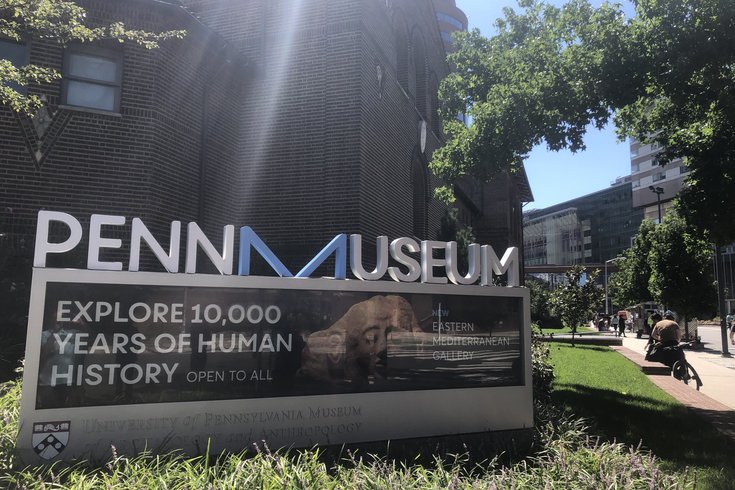
January 31, 2024
 John Kopp/for PhillyVoice
John Kopp/for PhillyVoice
The Penn Museum says it has buried 19 Black Philadelphians previously part of the Morton Cranial Collection ahead of a planned ceremony on Saturday. Some have expressed outrage at the museum's research methods, and exclusion of descendant groups.
Penn Museum had sparked weeks of uproar over its planned burial of the remains of 19 Black Philadelphians that have been in its collections for decades. Community organizers and some anthropologists had called the service, set to take place Saturday, "rushed" and "disrespectful."
Then, the museum quietly buried the remains ahead of schedule, alluding to it in a new announcement on Tuesday for weekend services, which will include a commemoration service and blessing. According to its website, the burial took place on Jan. 22.
"Following the recommendations of the Morton Collection Community Advisory Group, the Black Philadelphians in the Morton Collection have been laid to rest," a Penn spokesperson confirmed Wednesday. "After 200 years, it was time to respectfully lay them to rest."
That decision drew a strong rebuke from many people who opposed Penn Museum handling the burial. They included Lyra D. Monteiro, an assistant professor of history at Rutgers University, who had formally objected to Penn Museum's court petition to bury the remains.
"The folks I have been in touch with are just in shock, and think it's an assault," Monteiro said. "It's violent for them to have done this. I mean, how would you feel if somebody said, 'oh yeah, I didn't think you'd really care, so I just buried your grandma last week?'"
A Penn Museum spokesperson argued the institution had provided public notice, pointing to a Jan. 19 Facebook post that stated the 19 Black individuals would be laid to rest "next week." A tweet sent that same day, however, said the remains would be "respectfully laid to rest, Feb. 3." The spokesperson did not offer explanation for the conflicting social media messaging.
The museum's website also appears to have been updated after the burial took place. In screenshots of the Morton Cranial Collection page captured prior to the burial on Jan. 11 and four days later on Jan. 26, there is no reference to the Jan. 22 service, or any event other than the Feb. 3 public commemoration.
This event had inspired multiple letters of protest and condemnations from anthropologists who said the museum had not conducted enough research into the individuals now interred in Eden Cemetery in Collingdale, Delaware County. All of these individuals, the museum says, were previously part of the Morton Cranial Collection, an archive of more than 1,300 skulls the museum has managed since 1966. Samuel Morton, who collected and conducted research on the remains in the mid-1800s, was a Philadelphia physician who used the skulls to further white supremacist arguments about supposed biological inferiorities.
Museum officials said descendants and basic biographies could not be identified for the men and women, but critics argue they haven't looked hard enough. In the lead-up to the burial service, Finding Ceremony, an initiative working on behalf of descendant groups, unearthed significant information on another individual the museum had planned to bury, John Voorhees. The research revealed that Voorhees's mother was Indigenous, making his burial a violation of federal law.
In response to the research report, the museum said it would exclude Voorhees from the burial and follow the process outlined in the Native American Graves Protection and Repatriation Act. A Penn Museum spokesperson confirmed that Voorhees was excluded from the burial of the remains.
"They don't care," said aAliy Muhammad, one of the co-stewards of Finding Ceremony and a member of the Black Philadelphians Descendant Community Group. "I don't know how many times I can say that. They have not cared for these ancestors. They have not cared for community, and they won't care. That's the reason why we're saying they are not the correct institution. No institution should be doing this work at all. But Penn by far is the most incorrect institution to ever consider doing this work."
The complicated timeline that led to the burial stretches back to more than two centuries ago, when Morton began building his collection through a vast network of associates who, in some cases, plundered the skulls from graves or battlefields. After Morton's death in 1851, the Academy of Natural Sciences of Philadelphia bought his collection. The Penn Museum acquired it in 1966.
The collection was used for teaching and research purposes and partially displayed in University of Pennsylvania classrooms until 2020, when the museum undertook a reexamination of the collection apparently inspired by the racial justice protests over George Floyd's murder. Staffers relocated the crania to storage, and formed a committee and later an advisory group to make recommendations on the collection's future.
Muhammad was part of that advisory group, but broke with the museum over its first attempt at a burial service in 2022. When the Penn Museum petitioned the Orphans' Court to bury 13 Black Philadelphians in the collection, claiming consensus from the advisory group, Muhammad and Monteiro filed objections. The pair outlined a proposal for a descendant-led process that would transfer stewardship of the collection from the museum to Finding Ceremony, which would then create a complete catalog of every cranium and conduct research with the aim of identifying possible descendants. Penn Museum would provide funding, but relinquish all oversight.
"The point is that the decision is not made by the institution that caused the harm," Monteiro said.
The court ultimately sided with the museum last February, approving its plan to inter the individuals at Eden Cemetery, a historically Black burial site. Over the course of the proceedings, the number of individuals increased from 13 to 20 — another indication, Finding Ceremony argued, of the museum's mishandling and misunderstanding of the remains.
In December, the museum announced plans for its Feb. 3 ceremony, promising a 10 a.m. interfaith service outside the museum followed by a blessing at Eden Cemetery. The timeline fell just within the court's mandated burial deadline of one year from the ruling.
"After nearly 200 years these individuals are finally being returned to the Black community and laid to rest with respect," Christopher Woods, the director of the Penn Museum, said in a statement at the time. "This is a small but long-overdue step towards addressing injustices that have spanned centuries."
Critics, however, continued to voice objections to the plans. Aja Lans, a bioarchaeologist at Johns Hopkins University called the museum's research "egregious" in an interview with Science magazine. Kyle Olson, an archaeologist at Washington University at St. Louis who received his PhD from Penn, called on the museum to "do better by Philly" on X, formerly known as Twitter.
Meanwhile, Monteiro and other researchers affiliated with Finding Ceremony investigated Voorhees, the only person slated for burial with a name. By combing through the Chester County Archives and Records Service and other sources, Monteiro and her team discovered that Voorhees had a wife and a child and described his mother as an "Indian squaw" in an interview conducted shortly before his death. Penn Museum had written in a previously published document that "a review of finding aids for Archives and Records at the Chester County History Center of Pennsylvania did not reveal any information about Mr. John Voorhees."
"Our report very clearly laid out multiple methodological errors that the Penn Museum had made in their research, which is why they had not found the same information," Monteiro said. "I am a skilled researcher, you know, I am a professional archaeologist and historian, and I spend a lot of time in archives. But the University of Pennsylvania actually has a few professional historians itself, I think.
"(It) ultimately comes down to not caring enough to do the research, and also not realizing when they didn't know something."
Now with the burial completed, protestors have expressed shock and outrage on social media, calling the museum's actions "despicable" and a possible violation of court orders.
"This horrific happening also serves the purpose of gesturing that Black people in our lives and afterlives don't matter," Muhammad tweeted. "I'm really angry that this was allowed to take place. I'm sick to my stomach."
NOTE: This story has been updated with the burial date and additional information on the Penn Museum's previous invitations and social media messaging. Descriptions of Finding Ceremony and its affiliates have also been updated to more accurately reflect its work and organization.
Follow Kristin & PhillyVoice on Twitter: @kristin_hunt
| @thePhillyVoice
Like us on Facebook: PhillyVoice
Have a news tip? Let us know.